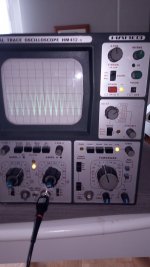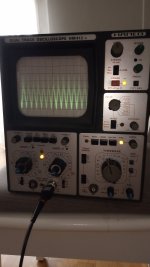Mine setup works better with DoP than Native DSDMany people prefer PCM over DSD. The claimed sound differences may well be due to additional intermodulation products caused by the ultrasonic noise of DSD.
As Archimago puts it (http://archimago.blogspot.com/2013/09/measurements-pcm-to-dsd-upsampling.html):
"Even though the noise is ultrasonic in nature as measured off the DAC, nonlinearities in the playback system like your headphones and speakers (perhaps certain amps as well) could create audible intermodulation. Maybe for certain music, this could be especially beneficial."
Hi Guys
Before I plunge into this rapid hole, I have some questions.
I am using the "Amanero+isolator+reclocker+DSC2" with potato chips and I currently use Jriver to upconvert everything to DSD.
I am also using Jriver to convolve the room correction files created with Audio Lense.
One of the consequences of this is that I cannot play back SACD/DSF/DSD files, because Jriver has to convert it to PCM first in order to use the convolver and then again convert to DSD and this cannot be done without glitches and gaps in playback.
Another restriction is that I want to use a subwoofer in my system and I want to use Audio Lense to make the crossover and timing of the Sub, and this means I have to have at least 4 channels (well actually 3) .
There is no USB to DSD solutions with more than 2 channels.
So my questions are:
What should I use as multichannel USB to I2S converter to use with this "Simple DSD modulator for DSC2" ?
There must be some kind of delay in the modulator, and Audio Lense can easily handle this, if it is a constant delay, but if it varies, it will not work. Is the delay constant in the modulator?
Before I plunge into this rapid hole, I have some questions.
I am using the "Amanero+isolator+reclocker+DSC2" with potato chips and I currently use Jriver to upconvert everything to DSD.
I am also using Jriver to convolve the room correction files created with Audio Lense.
One of the consequences of this is that I cannot play back SACD/DSF/DSD files, because Jriver has to convert it to PCM first in order to use the convolver and then again convert to DSD and this cannot be done without glitches and gaps in playback.
Another restriction is that I want to use a subwoofer in my system and I want to use Audio Lense to make the crossover and timing of the Sub, and this means I have to have at least 4 channels (well actually 3) .
There is no USB to DSD solutions with more than 2 channels.
So my questions are:
What should I use as multichannel USB to I2S converter to use with this "Simple DSD modulator for DSC2" ?
There must be some kind of delay in the modulator, and Audio Lense can easily handle this, if it is a constant delay, but if it varies, it will not work. Is the delay constant in the modulator?
A Beaglebone black with the Pure firmware from Pavel (https://puredsd.ru/) should be able to provide 4 DSD channels via I2S so you can hookup 2 (or even 3) DACs directly to it.
I think the problem with that solution is the room correction and crossover convolution. Can Pure handle that?A Beaglebone black with the Pure firmware from Pavel (https://puredsd.ru/) should be able to provide 4 DSD channels via I2S so you can hookup 2 (or even 3) DACs directly to it.
No, the Pure is the equivalent of the Amanero in your existing chain. What it brings is a 4 channel DSD capability over the network. You still need to upsample and convolve somewhere. The only software that can do native convolution on DSD is HQPlayer. You can potentially only do convolution on HQPlayer and put the simple DSD modulatator after the Pure to do the PCM to DSD conversion.
Ah I see.No, the Pure is the equivalent of the Amanero in your existing chain. What it brings is a 4 channel DSD capability over the network. You still need to upsample and convolve somewhere. The only software that can do native convolution on DSD is HQPlayer. You can potentially only do convolution on HQPlayer and put the simple DSD modulatator after the Pure to do the PCM to DSD conversion.
And an imbedded version of HQPlayer could do the convolution?
Or can I still use my windows pc to run HQPlayer on? BeagleBone with pure is it seen as an USB device or does it need to be coupled up using LAN?
So all I would need is a mono DSD dac (could be a simple No-DAC) ?
Hmmm I need to check the BeagleBone to see where the third channel DSD stream is ..
The beaglebone won't be powerful enough to do convolution so you'll have to do it on another PC. You'll probably have to use LAN with the HQPlayer NAA endpoint since the OTG USB drivers probably don't support DSD and I suspect the pure firmware doesn't include them anyway.
Ok so now it is HQplayer on a desktop doing the playback and convolution and upsampling to DSD in 4 channels.The beaglebone won't be powerful enough to do convolution so you'll have to do it on another PC. You'll probably have to use LAN with the HQPlayer NAA endpoint since the OTG USB drivers probably don't support DSD and I suspect the pure firmware doesn't include them anyway.
Pure is running on BBB and HQPlayer can see that on the LAN and use that instead of an USB device.
And all I have to do is to locate the pins on the BBB where the two extra channels of DSD is coming out and connect a DSD capable DAC to that?
Poor triggering due to high-frequency quantization noise? Does setting the triggering to LF make it better?What do you think of these double sinus?
The player DSD supportis set DoP.
https://www.minidsp.com/products/usb-audio-interface/mchstreamerThere is no USB to DSD solutions with more than 2 channels.
https://www.minidsp.com/products/usb-audio-interface/mchstreamer-lite
Tomorrow I will try & rapport, thanks.Poor triggering due to high-frequency quantization noise? Does setting the triggering to LF make it better?
Attached pic, using trigger set to Line because the image is clear than with LF. Scope set: 10mV/cm, 2ms & probe x10.
Attachments
Last edited:
That appears to be a 20MHz bandwidth scope, is that correct? If so, the DSD Converter is clocked at 22/24MHz. In order the the converter output signals to look approximately square, the scope and probe combined bandwidth should extend to at least 3 times the clock frequency. Better yet if it extends to 5 times the clock frequency. Also, probe capacitance and ground lead inductance can affect the actual signals being measured and or the waveform appearance on the scope. If you really mean you are trying to measure the Vrms output of the DSD Converter then you may have a problem.
OTOH if you are trying to measure the Vrms output of your DAC that's not quite the same thing. The scope might show the analog audio output signal level more or less correctly, particularly so if the DAC output is LP filtered to suppress RF and only leave audio band frequencies.
OTOH if you are trying to measure the Vrms output of your DAC that's not quite the same thing. The scope might show the analog audio output signal level more or less correctly, particularly so if the DAC output is LP filtered to suppress RF and only leave audio band frequencies.
Yes it's an old 20MHz bandwith scope. I will measure after the 4th order low pass filter that I use with the noDac, thanks.
Measurement after the 4th order LPF (deleted the other post because the gain setting was DC position in place of AC), it seems 60mVpp x10 probe = 600mVpp / 2.828 = 0.212Vrms??? I'm not sure if I do well the maths it seems a very low value.
Attachments
Last edited:
- Home
- Source & Line
- Digital Line Level
- Simple DSD modulator for DSC2




